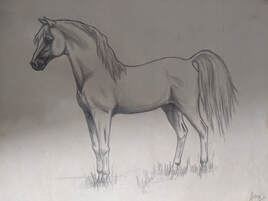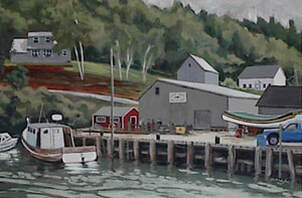|
An early sketch I drew as a teenager and a seascape from my years of painting realism. Change is inevitable. Looking back, we can see the changes in our own lives. As an artist, I look back over the years and consider how my painting has evolved over time.
I was drawing things probably as soon as I could hold a pencil. The sketching never stopped all through my school years and I drew everything from the horses I loved to copies of album covers. Every spare moment was a chance to pick up a pencil and draw what I saw around me. My mother was also an artist, and although I learned basic painting skills simply by watching her, I never really created any of my own paintings in those years. Perhaps I was intimidated by what I saw her create, but in any case, I held back and focused more on drawing. It wasn't until I had moved out on my own and started working, that I decided to try painting. Colour was a revelation. I was hooked. I decided to try acrylic paints which were still relatively new in those years, the vast majority of artists working in oil. I fell in love with the flexibility and quick-drying qualities of acrylic, even though I was told my paintings looked like they were done in oil. I attribute that to all those years I watched my Mom paint with her oils. It never occurred to me that the two mediums would be handled differently. At the same time as I was beginning to create my first paintings, I began attending workshops, taking art classes, and joining art groups in my spare time to soak up whatever I could learn about painting. My work took me across Canada and that enabled me to learn about art from different people, experience different approaches, and really expand my knowledge. In those early years, I was concentrating on realism, taking inspiration from the French Impressionists, the Group of Seven, and various other artists I admired. It was fun to explore, to try different techniques, learn new ways to see things. One thing I remember clearly was my absolute certainty that I would never create abstract paintings. At that time, they made no sense to me. The years passed and my work became more interpretive, looser. I began playing with the landscapes I created, my attention turning to unusual shapes, brighter colours, giving myself more freedom to play. I became obsessed with trying to create something that no one could capture with a camera. I was veering away from the realism I had always tried to attain with my landscapes, seascapes and portraits. I remember the day another artist I admired looked at my recent work, smiled and said, "You will be an abstract painter one day." No. I shook my head. That will never happen. And then it did. Making the decision to become an abstract painter was not a quick decision. I had gallery managers question my decision as, by this time, there were people following and collecting my realistic landscapes and seascapes. But I wanted the challenge. I wanted to see what I would create by looking inward instead of outward. Making the change in my style was probably one of the hardest things I've ever done with my art. There was a period of fumbling and experimentation. I had to allow myself to fail, miserably at times, to try again, and push forward. Slowly I began to see how my technique and approach had to change, and then of course, I had to forge my own path and try to create abstracts that were my own vision. I don't know if any art is truly unique. We are all influenced by the work of others, but as an artist, you strive to find something that is as nearly your own as possible. It is your artistic voice, as such. Which brings me to my current work. At this point in my life, it is important to me that my art communicates well, that it speaks as clearly as possible of things that matter to me in this life and time, even though the paintings are abstract in nature. I hope I come close because the journey that brought me here has been a joy and a wonder.
1 Comment
|
Anna Horsnell SCACanadian painter of contemporary abstract art Archives
June 2024
Categories |


 RSS Feed
RSS Feed